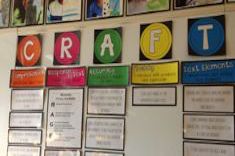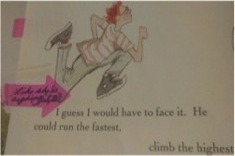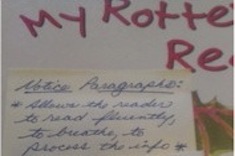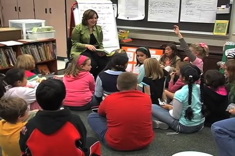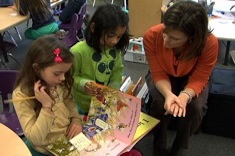I remember when I first learned about writing workshop. The philosophy of allowing children to grow in their writing by choosing their own topics, creating text with an inner purpose, and learning through individual conferences brought energy to my classroom. Trying to find the lessons to coordinate a unit of study, though, was overwhelming. I was an amateur, a novice seeking advice from the pros.
Katie Wood Ray, Ralph Fletcher, Carl Anderson, and Lucy Calkins were the pros I looked to. I learned about word choice, literary structure, author’s style and voice. These foundational craft moves expanded my understanding of “reading like a writer.” Their books shared not only the author’s craft, but books with corresponding minilessons. The glitch came when I couldn’t find a recommended book. I didn’t own it, or the book wasn’t in the school library, and the copy at the public library was unavailable. This was frustrating. My writing mentors had created great lessons to teach, and I was at a loss. I wanted to purchase the books, but my budget was limited. Other children’s books were at my fingertips, books I loved, yet they weren’t referenced. Could these books serve as substitutes?
First Steps in Designing Craft Lessons
In Wondrous Words, Katie Wood Ray urges teachers to spend time reading children’s literature. To read like a writer, she said, read, read, and read some more. So I did. I noticed a few craft moves, then a few more, and surprisingly more each time I read the book. Great authors were becoming my mentors. I began to notice other craft that wasn’t mentioned in the resource books. I added to Katie’s list in the sidebar of her book. My mind was full of words, structure, and voice.
I attended a study group with Carl Anderson, and he shared possible teaching points anchored in mentor texts he knew well. During one session, Carl challenged us to find as many minilessons as we could from My Mama Had a Dancing Heart by Libba Moore Gray. I began to notice basic writing skills: contractions, hyphenated words, rhyming. I dug deeper and found alliteration, power of three, and descriptive action. We were then asked to work with a small group and share what each of us had found. Amazing! My partners noticed that the ending replicated the lead, seasonal transitions, parallel structure in each scene, personification, and more until the author’s craft went from 5 to 8 skills to 27. How did this happen?
Each of us noticed different craft moves. Maybe those skills were ones we felt comfortable with, maybe those skills were based from stated standards, or maybe we practiced those skills in our own writing. No matter the reason, time spent in the text allowed us to notice more craft details.
The books I loved waited on the shelves nearby. They began to call my name, and I wondered, Can I find the craft in these books? Will I notice craft without relying on the resource books? Determined, I began to read the books sitting on my shelves. I love My Rotten Redheaded Older Brother by Patricia Polacco, so naturally I began with this favorite. I read the book. I reread the book, lingering longer in the beauty of words. I reread it again, stopping on each page to notice Patricia’s craft, pausing over phrases and paragraphs. I wanted to find as many craft moves as I could from my beloved book.
In My Rotten Redheaded Older Brother, Patricia begins with character descriptions of her grandmother, who brought her joy through storytelling, and her brother, who tormented her. Similes such as “looked like a weasel with glasses” create the tone of her disdain for Richard along with realistic banter throughout the preliminary story. I found show-not-tell articulating the younger sister’s frustration, and a repeating line of “four years older than you” triumph of the older brother dominating. The rule of three, time transitions, and exploding-the-moment scenes were embedded throughout the story. On each page, I combed through the words, remembering what I learned from the pros, and found a touchstone text for minilessons.
The art of noticing is twofold. Begin by lingering in the words of a book you know well, rereading and pondering how the author crafts her words. Second, name the craft you recognize. I often use Wondrous Words as a reference for craft. Keep sticky notes on hand, especially during a read-aloud. When you notice beautiful words, mark the page and keep reading. Later, return to the book and name the craft or skill you noticed.
Harvesting craft in a touchstone text requires several readings and digging deeper. Sticky notes are essential for retaining what you notice. Begin with the words that stand out. Reread the text, looking beyond the meaning to the way words are woven together. Is the craft word choice, figurative language, or part of a structural move? I often read a two-page spread a number of times, listing skills. On the next two-page spread, I will write more skills. By the third set, I begin to compare what I noticed. Is the author repeating a craft? If a particular craft stands out, I narrow my focus, searching for more of the same on the following pages. This exercise of reading and noticing sharpened my skill of gathering craft. These craft moves then become the basic examples for minilessons.
As a novice learning from the pros, I learned to linger in the words and notice craft moves. I expanded my ability to find minilessons in the books I loved. My knowledge of craft deepened with each reading. I encourage you to take time to read like a writer. Read to notice, and you will have the freedom to teach with books you love.

